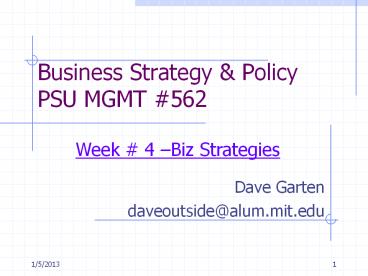Business Strategy & Policy PSU MGMT 562 - PowerPoint PPT Presentation
1 / 17
Title:
Business Strategy & Policy PSU MGMT 562
Description:
Business Strategy & Policy PSU MGMT #562 Week # 4 Biz Strategies Dave Garten daveoutside_at_alum.mit.edu * * * * * Dave Garten - Business Strategy * Yet – PowerPoint PPT presentation
Number of Views:58
Avg rating:3.0/5.0
Title: Business Strategy & Policy PSU MGMT 562
1
Business Strategy Policy PSU MGMT 562
Week 4 Biz Strategies
- Dave Garten
- daveoutside_at_alum.mit.edu
2
Yet
What new core competencies do we need to
build? What new product concepts should we
pioneer? What alliances do we need to form? What
l/t regulatory initiatives do we need to form?
Source Derived from Competing for the Future by
Gary Hamel and C.K. Prahalad
3
Differentiation
increase in perceived value relative to the
perceived value of other firms - Barney
If you cant differentiate yourself in this
world, you get commoditized instantaneously. So
we are constantly driving for more innovation,
more differentiation and more technology. -
Jeffrey R. Immelt, Chairman and CEO, GE
4
Differentiation
- Why differentiate?
- Ways to differentiate
X
5
Differential (Segmentation)
- Segmentation is basis for differentiation
- Determines the value proposition
Segment via benefits, demographics and
psychographics
6
The Basis for Segmentation
Size Technical sophistication OEM/replacemen
t
Industrial buyers
Characteristics of the Buyers
Demographics Lifestyle Purchase occasion
Household buyers
Size Distributor/broker Exclusive/
nonexclusive General/special list
Distribution channel
Opportunities for Differentiation
Geographical location
Physical size Price level Product features
Technology design Inputs used (e.g. raw
materials) Performance characteristics Pre-sales
post-sales services
Characteristics of the Product
Source Jim Goes
7
Differentiation - observations
- 5 forces differentiation lowers threat of
rivalry substitutes (barriers to entry) - VRIO tests differentiation rare imitable?
- Differentiation narrows with life cycle
- Brand can limit differentiation
- Patents can enhance differentiation
- Organization is a source of differentiation
- Creativity, risk-taking, complexity, cross group
(link to core competency)
8
Segmentation - U.S. Bicycle Industry
SEGMENT
KEY SUCCESS FACTORS
Low price bicycles sold primarily through
department and discount stores, mainly under the
retailers own brand (e.g. Sears Free Spirit)
Low-costs through global sourcing of components
low-wage assembly. Supply contract with
major retailer. Leading competitors Taiwanese
Chinese assemblers, some U.S manufacturers, e.g.
Murray Ohio, Huffy
Medium-priced bicycles sold primarily under
manufacturers brand name and distributed mainly
through specialist bicycles stores
Cost efficiency through large scale operation
and either low wages or automated
manufacturing. Reputation for quality
(durability, reliability) through effective
marketing to dealers and/or consumers.
International marketing distribution. Leading
competitors Raleigh, Giant, Peugeot, Fuji
(Japan).
Quality of components and assembly, Innovation
in design (e.g. minimizing weight and wind
resistance). Reputation (e.g. through success in
racing, through effective brand
management). Strong dealer relations. Leading
competitors K2, Specialized, Trek
High-priced bicycles for enthusiasts.
Childrens bicycles (and tricycles)
sold primarily through toy retailers (discount
toy stores, department stores, and specialist
toy stores).
Similar to low-price bicycle segment.
Source Jim Goes
9
Cost Leadership
- Manufacturing businesses
- Conventional High MSS -gt High accumulated volume
? low unit cost -gt high profitability - Experience curve (learning), know-how, IP,
specialization, improvements - Service businesses
- Know-how experience curve applies
- Diseconomies sometimes
- Cost structure
- Labor, capital, land, raw materials, geography,
use of technology, government policy
Source Derived from Barney, Gaining
Sustaining Competitive Advantage
10
Drivers of Cost Advantage
11
Cost Leadership Observations
- 5 Forces
- Entrants often try differentiation to attack
- Threat of substitution check balance
- Scale -gt more power relative to
suppliers/customers - VRIO test rarity imitability
- Social complexity (learning curve), access to low
cost factors, software - Price-cost decoupling
- TTM, penetration and defensive strategies
- Pure play cost leadership
- Generally notLean and mean
12
Airline Cost/Differentiation
13
Low Cost Entry
Source Strategies to Fight Low Cost Rivals, by
Nurmalya Kumar, HBR, 2006 (R0126F)
14
Vertical Integration
- Degree of control over the value chain
- Forward -gt toward customer
- Backward -gt toward RD
- Driven by relationship, threat of opportunism,
specificity, uncertainty
15
Vertical Integration
Vertical Integration
Market Governance
Alliances
- Plus of vertical integration
- Minus of vertical integration
X
16
Time to Market
- Learning curve advantages
- First use stickiness
- Brand, differentiation, reputation
- Creation of standard, expectations
- Networking effect
- Interoperability, Value f(n2)
- Arrows in the back
- Incumbent, imitation, mistake
- Windows
- Always learn and adjust
17
Mondavi Case
- Objective Evaluation of business strategies used
in the wine industry - Learnings
- Industries exhibit different structures across
geographies. - Use of different strategies is used within an
industry to gain competitive advantage. - Consolidation as a strategy is most often driven
by economies of scope/scale, but other
considerations become factors.































